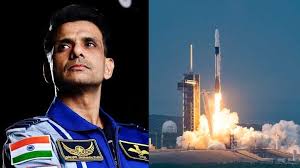
After a historic gap of 41 years since Rakesh Sharma's mission, an Indian astronaut has returned to space, embarking on a groundbreaking mission to the International Space Station (ISS) in 2025. This marks a major milestone in India’s space exploration journey and showcases ISRO’s growing global collaboration in human spaceflight. The event holds key significance for current affairs and UPSC aspirants alike.
On Wednesday, India marked a significant milestone in its space journey as Group Captain Shubhanshu Shukla was launched aboard the Axiom-4 (Ax-4) mission to the International Space Station (ISS). This is the first time in 41 years that an Indian has ventured into space, and notably, it is the first instance of an Indian astronaut visiting the ISS.
Significance of the Event:
Revival of India’s Human Spaceflight Aspirations: Group Captain Shukla’s mission is being hailed not merely as an individual achievement, but as the symbolic beginning of India's full-fledged entry into human spaceflight. His words from space — “This is not the start of my journey to the ISS but the start of India’s human space programme” — underscore this sentiment.
Strategic Leap Towards Gaganyaan: India’s indigenous human spaceflight programme, Gaganyaan, aims to send Indian astronauts (Gagannauts) into low Earth orbit. The Ax-4 mission offers valuable operational insights into long-duration human presence in space, serving as a precursor to Gaganyaan, planned for launch in the near future.
Strengthening International Collaborations: The mission is part of Axiom Space’s commercial venture, with participation from the U.S., Poland, Hungary, and now India. It highlights India’s willingness and capability to partner in global commercial and scientific space initiatives.
Science Diplomacy and Outreach: With 60 scientific activities from 31 countries, the mission embodies science diplomacy. India’s involvement elevates its profile in global research and innovation in space-based studies like microgravity research, biotechnology, material science, and international cooperation in space education.
Public Inspiration and Soft Power: Shukla's participation rekindles public imagination and interest in space exploration, especially among youth. This mission strengthens India’s soft power and its image as an emerging leader in space technology.
Challenges and Way Ahead:
Institutional Preparedness: While ISRO has demonstrated technical excellence in unmanned missions, human spaceflight demands higher safety, life support systems, and crew training. Missions like Ax-4 help bridge the experience gap.
Funding and Commercial Viability: India must ensure adequate funding for its human space programme and explore commercial partnerships to sustain long-term ambitions.
Global Standards and Sustainability: Human space missions require adherence to international norms related to space debris, crew safety, and sustainable orbital practices.
Infrastructure Development: India will need advanced astronaut training facilities, re-entry technologies, and coordination with global space agencies and private players.
Conclusion:
The successful launch of Group Captain Shubhanshu Shukla aboard the Ax-4 mission marks a watershed moment in India’s space history. Beyond its scientific relevance, it signifies India's arrival as a serious contender in the domain of human spaceflight. The mission is not just a commemoration of past glory — it is a declaration of future intent, ambition, and global partnership. For UPSC aspirants, this development is a testament to India’s space diplomacy, technological progress, and soft power projection on the world stage.
UPSCMainsPractice Question
Ques : "India’s participation in the Ax-4 mission marks a new chapter in its human spaceflight journey."Discuss the significance of this development for India's space programme and its implications for Gaganyaan and beyond.(250 Words)
12-Jul-2025 05:35 PM
Prime Minister Narendra Modi emphasized the critical role of the...
12-Jul-2025 05:26 PM
Endocrine disruptors found in plastic waste pose a serious public...
12-Jul-2025 04:26 PM
Prime Minister emphasized that BRICS aims to create a balanced,...
12-Jul-2025 04:17 PM
A recent study highlights that the Sinhalese community of Sri...
08-Jul-2025 05:33 PM
A renewed global and national commitment has been made to...
08-Jul-2025 05:21 PM
The Andhra Pradesh government has approved the Amaravati Quantum Valley...
Leave a Comment